Pink chaparral currant (
Ribes malvaceum) revives the sleeping garden with elegant pink tassels and handsome mallow-like leaves on its upright branches. The white to pink flowers bloom as early as October and continue as late as March. It is an important nectar source for winter hummingbirds, who find its offerings seductively delicious. As the season warms, other pollinators enjoy its sweet nectar. The tassels are followed in spring by edible fruit that ripens to a dusty blue-purple.
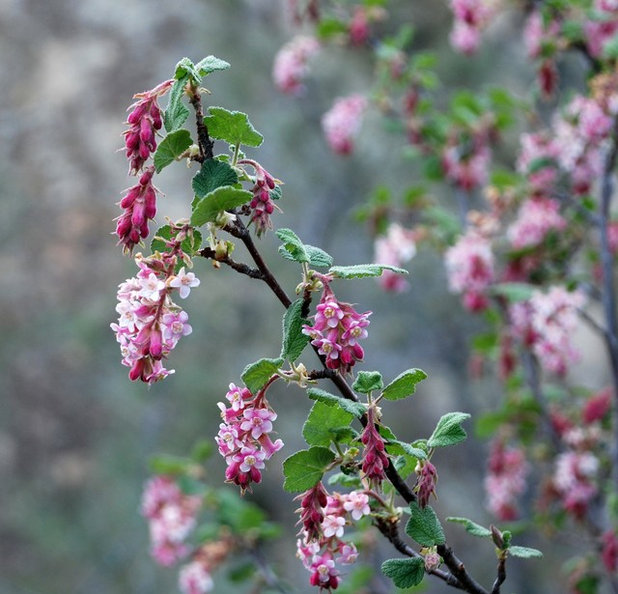
Pete Veilleux, East Bay Wilds
Botanical name: Ribes malvaceum Common name: Pink chaparral currant
Origin: Inner North Coast Ranges, Sierra Nevada foothills, San Francisco Bay Area, South Coast Ranges, Channel Islands, northern Baja California
Natural habitat: Chaparral, closed-cone pine forest, mixed evergreen forest, central oak woodland, foothills and canyons; below 4,500 feet
Where it will grow: Hardy between 0 and 35 degrees Fahrenheit (USDA zones 7 to 10; find your zone)
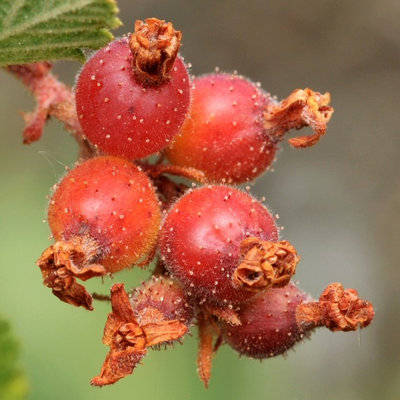
Treebeard
Water requirement: Drought tolerant to moderate water
Light requirement: Full sun on the coast and in cool climates; partial shade inland
Soil requirement: Adaptable; needs good drainage
Mature size: 5 to 6 feet tall and wide; some cultivars can grow larger
Benefits and tolerances: Moderately deer tolerant; great for slopes and under oak trees; the leaves can be used in tea; the fresh berries are edible but aren’t tasty to people — unless cooked, they are better left to the birds
Seasonal interest: Fall to spring blooms and spring berries
When to plant: Late fall is ideal; winter works well; early spring can be acceptable; summer is challenging to all but the most experienced gardener
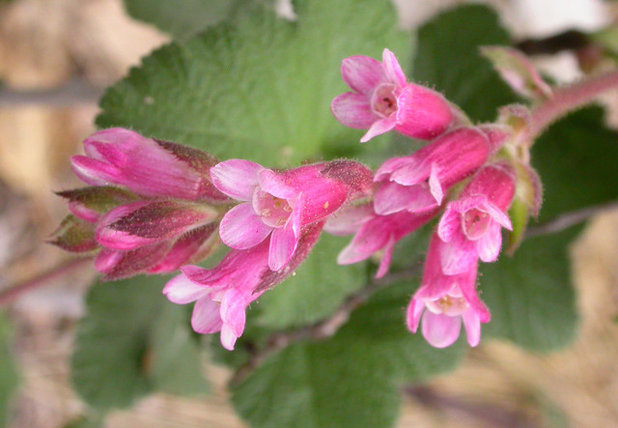 Photo by Curtis Clark
Photo by Curtis Clark
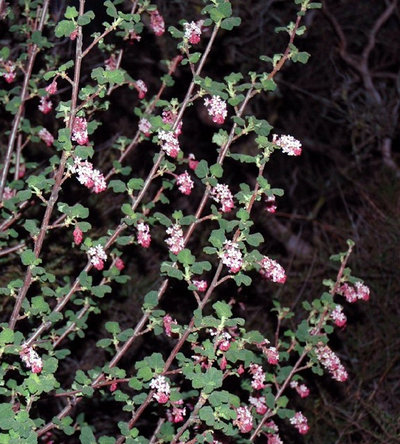
Pete Veilleux, East Bay Wilds
Distinguishing traits. Pink chaparral currant is a drought-tolerant, fast-growing upright shrub with gorgeous tassels of pink blooms from fall to spring and edible berries from spring to summer.
Wildlife value. Hummingbirds seek its nectar in winter; other birds eat the berries in spring and summer; the tailed copper butterfly (
Lycaena arota) uses Ribes species as host plants for its larvae.
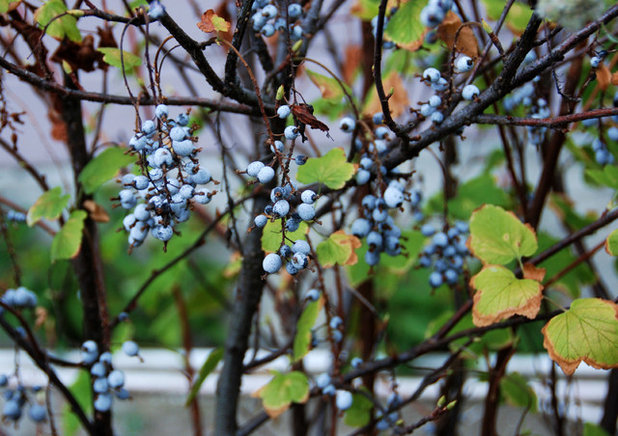
Pete Veilleux, East Bay Wilds
Although the fresh berries are somewhat bland, they make a nice currant jam or jelly or even a tart. I have heard that you can make an aromatic tea simply by adding a leaf of
malvaceum to a favorite peppermint tea.
Of the pink-flowering Ribes
species,
malvaceum is considered the most drought tolerant and is a good example of California’s adaptable plants. Remember that “drought tolerant” often means “drought deciduous.” This plant will drop its leaves during summer to cope with heat and our typical dry summers.
Malvaceum won’t disappoint when it blooms and leafs out. New foliage and flowers appear after the first rain, or maybe with your fall irrigation.
Ribes
species are the highlight in my winter garden — the flowing flower tassels enchant all who see them, and the bounty of nectar and berries invites the critters to come play and eat.
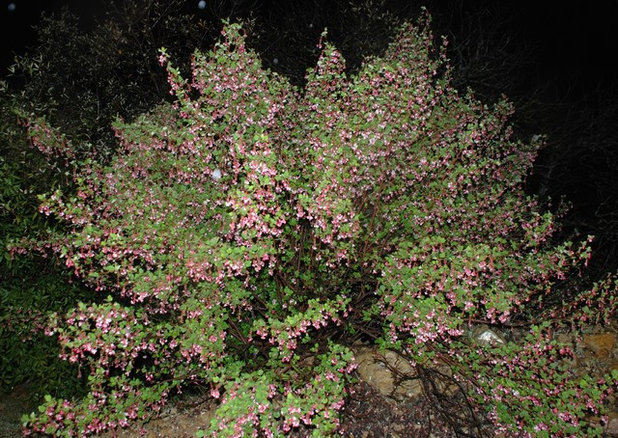
Pete Veilleux, East Bay Wilds
How to use it. Malvaceum can be used as a backdrop or a low screen, on dry slopes or under oaks or in a border. Choose a site with plants that look better during the summer, like monkeyflower (
Mimulus aurantiacus), evergreen currant (
Ribes viburnifolium)
and toyon (
Heteromeles arbutifolia). For a woodland look, I love to combine
malvaceum with evergreen currant, Bolander’s phacelia (
Phacelia bolanderi), Douglas iris (
Iris douglasiana), hummingbird sage (
Salvia spathacea) and coffeeberry (
Frangula californica)
. Natural companion plants include toyon, coffeeberry, manzanita (
Arctostaphylos manzanita), monkeyflower, buckwheat (
Eriogonum fasciculatum), matilija poppy (
Romneya coulteri) and white sage (
Salvia apiana).
Malvaceum is recommended for dry shade under oaks. It’s important to keep in mind that our native oaks are susceptible to fungal diseases, such as oak root fungus and crown rot. During warm months the ground under a native oak should not be moist within several feet of the crown. Fungus-resistant plants like Ribes should be selected and then sited at least 6 to 10 feet from an oak’s crown. California Oaks has more information about planting under and around oaks.
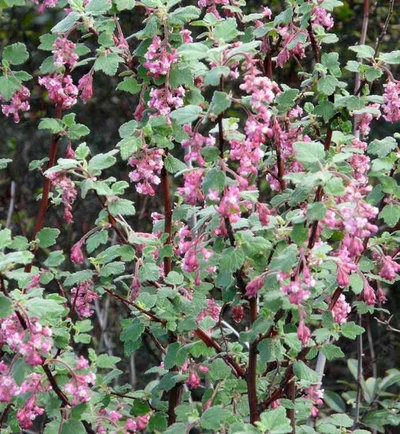
Las Pilitas Nursery
Planting notes. Native plants aren’t drought tolerant until they are established. Give
malvaceum deep drinks for the first few summers, until it suddenly flushes with growth. Once established,
malvaceum won’t want water during the warm months. If you want it to look a bit better through the summer, simply add mulch and give it extra water in the cool fall and spring, thereby extending the rainy season.
Malvaceum does well when provided with good drainage and full sun on the coast or partial shade inland. Other than a rare pruning during the dry season for shape and width,
malvaceum is easy and requires little care. Avoid cutting back old wood, because the somewhat hollow stems can collect moisture and introduce disease.
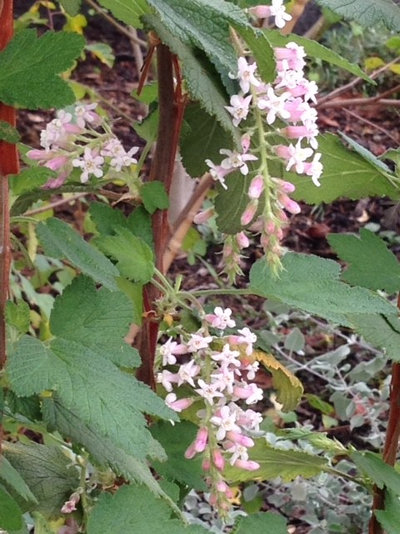
Sally Levinson
Selected cultivars include:
- ‘Dancing Tassels’: Dancing Tassels chaparral currant (shown here) was selected by Rancho Santa Ana Botanical Garden and is originally from San Clemente Island, California. It has the largest flowers of any chaparral currant, with pale pink tassels 4 to 5 inches long. Dancing Tassels is also a larger plant, reaching 6 to 8 feet tall and wide.
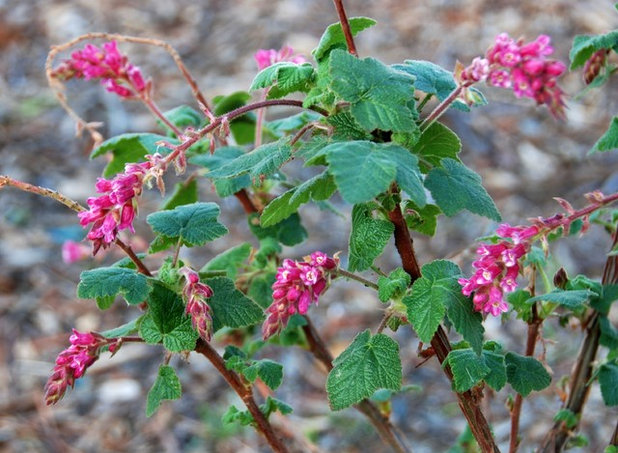
Pete Veilleux, East Bay Wilds
- ‘Ortega Beauty’: Ortega Beauty chaparral currant (shown here) is a 6-foot-tall selection of the Southern California version of pink chaparral currant (R. malvaceum var. viridifolium). Originally found in the Ortega Mountains by Nevin Smith, it is most known for its deeper green leaves and stunning red tassels — as red as the flowers of the popular Ribes sanguineum.





